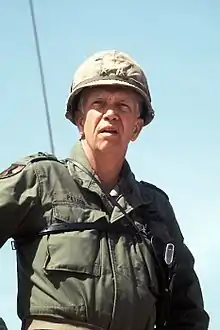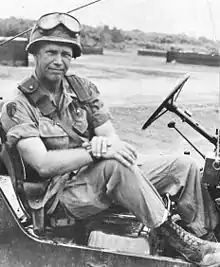George Patton IV
George Smith Patton IV (December 24, 1923 – June 27, 2004) was a major general in the United States Army and the son of World War II General George S. Patton Jr. He served in the Korean War and the Vietnam War.
George Smith Patton IV | |
|---|---|
 Patton in 1977 | |
| Born | December 24, 1923 Boston, Massachusetts |
| Died | June 27, 2004 (aged 80) South Hamilton, Massachusetts |
| Buried | |
| Allegiance | United States |
| Service/ | United States Army |
| Years of service | 1942–1980 |
| Rank | Major General |
| Commands held | 2nd Armored Division 11th Armored Cavalry Regiment 2nd Medium Tank Battalion |
| Battles/wars | Korean War Vietnam War |
| Awards | Distinguished Service Cross (2) Silver Star (2) Legion of Merit (3) Distinguished Flying Cross Bronze Star Medal (2) Purple Heart |
| Relations | George S. Patton (father) Beatrice Ayer Patton (mother) George Smith Patton (grandfather) Frederick Ayer (grandfather) |
| Other work | Farmer Co-author, The Fighting Pattons |
Military career
Patton was educated at The Hill School. A 1946 graduate of the United States Military Academy,[1] Patton was initially trained as an infantry officer. His first assignment was to Regensburg, West Germany, where he participated in the 1948 Berlin Airlift. The troops under his command were used to load supplies onto Air Force transport aircraft bound for Berlin. In 1952, he joined C Company, 63rd Tank Battalion, 1st Infantry Division, as a platoon leader. A year after he returned from Germany, he married Joanne Holbrook.
Korean War
Patton served in the Korean War from February 1953, commanding "A" Company of the 140th Tank Battalion, 40th Infantry Division.[2] He received his first Silver Star and the Purple Heart in Korea.
Returning to the United States in 1954, Patton, now a captain, was initially assigned to West Point, but was quickly picked up as part of an exchange program and was sent to teach at the United States Naval Academy.[3]
Vietnam War
Patton served a total of three tours of duty in South Vietnam, the first from April 1962 to April 1963 at Military Assistance Command, Vietnam, during which he was promoted to lieutenant colonel. He then took command of the 2nd Medium Tank Battalion, 81st Armored Regiment of the 1st Armored Division at Fort Hood Texas, before his second tour in 1967, this one lasting only three months.[4] During Patton's final and most intense tour, lasting from January 1968 to January 1969, he was awarded two Distinguished Service Crosses for his actions on the battlefield. During this final tour, he was initially assigned as Chief of Operations and Plans at Headquarters, United States Army Vietnam. However, after his promotion to colonel in April 1968, he was given command of the 11th Armored Cavalry Regiment. During his three tours in Vietnam, Patton, who frequently used helicopters as a mobile command post, was shot down three times and was awarded the Distinguished Flying Cross.
Post-war
After Vietnam, Patton was promoted to brigadier general in June 1970 before becoming the commanding general of the 2nd Armored Division, in 1975, as a major general. This was a unit his father had commanded just before the United States had entered World War II, making this the first time in United States Army history that a father and a son had both commanded the same division.
Brigadier General Patton was Deputy Post Commander at Fort Knox, Kentucky during 1972. He was also Assistant Commandant of the Armor School at the same time.
Patton was assigned to the VII Corps in Germany, as the Deputy Commander. He was stationed near Stuttgart, where Manfred Rommel, son of Field Marshal Erwin Rommel, was a government official who later became the city's mayor.[5] The sons of the two former adversaries entered a much publicized friendship, which continued until Patton's death in 2004. The two men shared the same birthday, December 24. From 5 August 1975 to 3 November 1977, he commanded the 2nd Armored Division at Fort Hood, Texas.
Awards and decorations
Patton's military awards include:
- Badges
 Parachutist Badge Parachutist Badge |
- Decorations
| Distinguished Service Cross with bronze oak leaf cluster | |
| Silver Star with bronze oak leaf cluster | |
| Legion of Merit with two bronze oak leaf clusters | |
| Distinguished Flying Cross | |
| Bronze Star Medal with "V" Device and bronze oak leaf cluster | |
| Purple Heart | |
| Meritorious Service Medal | |
| Air Medal with award numeral 27 | |
| Army Commendation Medal with three bronze oak leaf clusters |
- Unit Award
| Army Presidential Unit Citation |
- Service Medals
| American Campaign Medal | |
| World War II Victory Medal | |
| Army of Occupation Medal with 'Germany' clasp | |
| National Defense Service Medal with bronze service star | |
| Korean Service Medal with two bronze campaign stars | |
| Vietnam Service Medal with silver and two bronze stars |
- Foreign Awards
| Republic of Vietnam Army Distinguished Service Order (2nd Class) | |
| Republic of Vietnam Gallantry Cross with Silver and two Bronze Stars | |
| Republic of Vietnam Armed Forces Honor Medal, 1st Class | |
| Republic of Korea Presidential Unit Citation | |
| Republic of Vietnam Gallantry Cross Unit Citation | |
| United Nations Korea Medal | |
| Republic of Vietnam Campaign Medal | |
| Republic of Korea War Service Medal |
Post-military work and death

In the years after his 1980 retirement, Patton turned an estate owned by his father located north of Boston into the Green Meadows Farm,[6] where he named the fields after soldiers who died under his command in Vietnam.
During the first years after his retirement from the Army, Patton was interviewed by journalist Kim Willenson for his book The Bad War: An Oral History of the Vietnam War, which was published in June 1987. In the 1990s, Patton worked alongside author Brian Sobel to write The Fighting Pattons, a book that serves as an official family biography of his father as well as a comparison between the military of his father's generation and that of his own, a time which covered five conflicts and almost 70 years of combined service. The Fighting Pattons was published in 1997.
He died from a form of Parkinson's disease at the age of 80 in 2004.
His youngest son Benjamin Patton has written a family biography entitled Growing Up Patton: Reflections on Heroes, History, and Family Wisdom, which reflected on his grandfather and father's careers.[7][8]
Family name
Patton was the fourth in his line to be named George Smith Patton. His great-grandfather, the first George Smith Patton, was a colonel in the Confederate States Army during the American Civil War. He was killed in 1864, at the Battle of Opequon. Patton's grandfather, born George William Patton in 1856, changed his name to George Smith Patton in 1868, in honor of his father. Patton's father was George Smith Patton Jr., the renowned World War II general most famous for his command of the Third U.S. Army in Northwest Europe in 1944 and 1945.
Though given the name Junior, Patton's father was actually the third George Smith Patton. For this reason, Patton was christened George Smith Patton IV. Following his father's death in 1945, Patton changed his legal name to George Smith Patton, dropping the Roman numerals.
His eldest son, technically the fifth George S. Patton, is also known as George Smith Patton Jr. WW II General Patton's young grandson, who still is living, has given interviews on the History Channel and the Military Channel, recalling his family heritage.
Another son, Robert H. Patton, has written a history of the Patton family: The Pattons: A Personal History of an American Family (Crown, 1994).[9][10]
Another son, filmmaker Benjamin W. Patton, recorded tapes of his father's memories of his own and his grandfather's experiences, and those tapes formed the basis of the book The Fighting Pattons by Brian M. Sobel.[11][12]
References
- Biography for George S. Patton IV at IMDb
- "Letters, Jun. 29, 1953". Time. June 29, 1953. Retrieved May 3, 2010.
- Sobel, Brian (1997). Google books. Greenwood Publishing Group. ISBN 978-0-275-95714-8.
- Moïse's Bibliography: U.S. Military Men
- Sobel, Brian M. (1997). The Fighting Pattons. Greenwood Publishing Group. p. 94. ISBN 978-0-275-95714-8.
- Harlow, Michael (July 8, 2018). "Historic Massachusetts farm cultivates medical cannabis with a social conscience". Retrieved April 5, 2020.
- "Growing Up Patton". Time. 26 March 2012.
- "For General Patton's Family, Recovered Ground". Smithsonian. June 2009.
- Rierden, Andi (12 June 1994). "The Patton Family: An Intimate Portrait". The New York Times. Retrieved 30 June 2016.
- Patton, Robert (1 March 1994). The Pattons: A Personal History of an American Family (1st ed.). Crown Publishing Group. pp. 320. ISBN 0517590689. Retrieved 30 June 2016.
- Patton, Benjamin. "For General Patton's Family, Recovered Ground". Smithsonian.com. Smithsonian Institution. Retrieved 30 June 2016.
- Sobel, Brian (25 February 1997). The Fighting Pattons (1st ed.). Praeger; Greenwood Publishing Group. p. 288. ISBN 0275957144.
External links
| Wikiquote has quotations related to: George Patton IV |
- George Smith Patton, at ArlingtonCemetery•net, an unofficial website – reprints obituaries
- George Patton IV at Find a Grave

- Webcast presentation by Patton's son, Benjamin, at the Pritzker Military Library on October 18, 2012 regarding his book Growing Up Patton: Reflections on Heroes, History and Family Wisdom